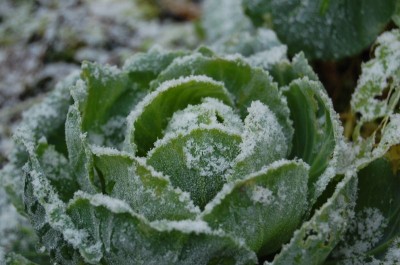 Are you tired of looking out at a desolate and dead yard all winter long? This year, consider starting a winter garden! Even though gardening is considered a summer hobby, the rewards don’t have to stop when the days get shorter. With a little planning and work, you can keep on enjoying a few select vegetables well into the winter months. Of course, certain zones are better than others, and most of us have to plan on the risk of frost starting in October. However, there are plenty of vegetable varieties that can tolerate the cold and there are constructive ways to help your plants combat the cold.
Are you tired of looking out at a desolate and dead yard all winter long? This year, consider starting a winter garden! Even though gardening is considered a summer hobby, the rewards don’t have to stop when the days get shorter. With a little planning and work, you can keep on enjoying a few select vegetables well into the winter months. Of course, certain zones are better than others, and most of us have to plan on the risk of frost starting in October. However, there are plenty of vegetable varieties that can tolerate the cold and there are constructive ways to help your plants combat the cold.
Leafy vegetables like spinach, lettuce, kale, and cabbage grow well in the colder months, as do mustard, garlic, broccoli, and turnip plants. The key is to plant in early fall and protect these plants during cold temperatures. Most of these plants can’t handle temperatures lower than 20°F, so plant accordingly.
Cold Hardy Varieties
When preparing your winter garden, look for these cold hardy varieties:
- Lettuce – Winter Density, Winter Gem, San Martino
- Kale – Siberian Kale or Lacinato Kale
- Spinach – Giant Winter, Riccio d’Asti, Merlo Nero
- Mustard – Even’ Star Farm varieties
- Cabbage – Mammoth Red Rock or Nero Di Toscana
- Broccoli – Green Comet or Green Goliath
Winter is Coming…
Don’t let plants that you won’t be harvesting any longer just sit in your garden during the fall and summer – they’ll continue to take up nutrients and precious space. Before you get started planting your winter vegetables, give your garden a healthy dose of an organic fertilizer or mix in some compost. This will help replenish the soil’s nutrients after your summer plants have used it up.
Without A Doubt The Best Kept Secret In Self-Reliance Gardening…
Before planting, layer the top of your garden with peat moss, bark, sawdust, or shredded newspaper. These mulches help protect the delicate root systems from too cold of temperatures.
Experienced gardeners will tell you that a little chill in the air makes for crisper, more flavorful vegetables. Many of the great winter vegetables can survive a frost or two. Keep in mind – these vegetables will grow a bit slower than they would in summer due to the reduced sunlight. Broccoli, lettuce, kale, spinach, and turnips are very hardy vegetables. Plan on getting your veggies in the ground a few weeks before the first frost date in your area.
Your plants’ water requirements will be lower than in the summer because the heat will no longer sap up a lot of the moisture. Plan on watering during the “hottest” part of the day to avoid chilling the roots too much. Also, avoid getting water on the foliage, focusing only on the soil. This will help prevent frost and ice build-up on the leaves.
For broccoli, lettuce, and spinach plants, start the seeds indoors in June or July, or buy established plants from a garden center. If you’ve grown lettuce, kale, or spinach before, you know how quickly it can bolt in the summer months. With a winter garden, you no longer have to worry!
Protecting Your Winter Garden
Once you have plants happily growing in your winter garden, you need to protect them on days when temperatures will be lower than 20° to 30°F. One method is to simply cover the vegetable plants up with large pieces of cheesecloth or clear agricultural cloth. While this isn’t a sure-proof method, it’s the easiest way to protect your veggies. Raised gardens usually have warmer temperatures than their “level ground” cousins do. Also, putting a wall around your garden helps block chilling winds from reaching your plants.
As Off The Grid News recently discussed, cold frames are one of the most proven ways to lengthen a growing season and protect your delicate plants from harsh temperatures. A cold frame looks a bit like a green house, and it’s basically a bottomless case that you put over your plants. It has a transparent glass or plastic lid that lets sunlight in, and when temperatures are too low, you can close the “case” to keep the temperatures up inside. You can buy a cold frame already made for you, or you could make your own out of wood, old windowpanes, or a strong, stiff plastic. If this sounds like too much work, you can also use plastic bottles to fit around your plants. Water cooler bottles and large gallon bottles work best. Cut off the bottom and fit around the plant.
To take cold frames one step further, hotbeds are basically cold frames with a heated bottom. This could be from heating cables, heating pads, or a layer of decomposing compost under the plant (decomposing compost produces heat).
Using a combination of the methods above, along with choosing cold hardy varieties, should ensure you’ve got veggies for almost the whole year! Get used to people asking how you did it!
 Off The Grid News Better Ideas For Off The Grid Living
Off The Grid News Better Ideas For Off The Grid Living




